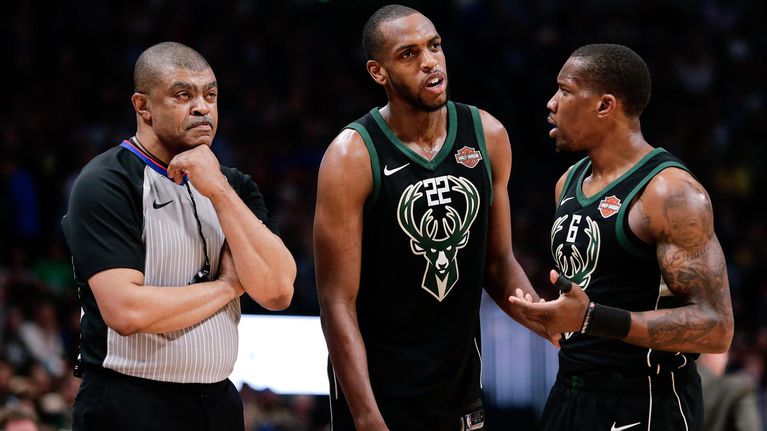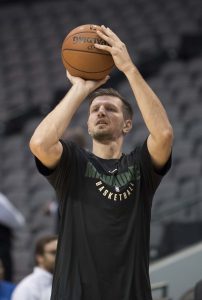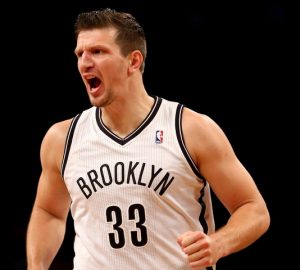
Referee Tony Brothers’ crew called 10 fouls on the Bucks in the 4th quarter Sunday night in Denver, to 2 on the Nuggets as the Nuggets overcame a 18-point deficit to force overtime and beat the Bucks, 128-125. Khris Middleton (middle) and Eric Bledsoe might be wondering here why the Nuggets shot 46 free throws in all, including the game-tying trio by Jamal Murray. AP photo: License: Standard non-commercial use.
There was a lot wrong with the Bucks mind-boggling, overtime loss to the Nuggets in Denver Sunday night, which featured the Bucks blowing a 17 point lead with 6 minutes to play in regulation. They had the ball too at that point, ahead by 17, the clock marching down under 6:00. Instead of slowing the pace to run some offense, Bucks center John Henson cut to the basket and tried to dunk on Nikola Jokic. Henson missed the dunk, and a few seconds later Jamal Murray buried a three to cut the lead to 14. Suddenly, it wasn’t the Nuggets reeling from the 3-pointer Bledsoe had hit prior to Henson miffing the dunk, it was the Bucks calling time out to regroup with 5:44 to go.
The mindlessness of that play seems to speak for every mindless play made by the Bucks on their way to their 36th loss, 128-125 in OT, and a return to 8th place in the East. Henson wasn’t close on dunk (which isn’t the sort of video that gets cut and distributed in the NBA), but he didn’t appear to get above the rim as he rose to the basket and slammed the ball into the side of the iron.
The “J-Hook” also failed to grab a single rebound in the 4th quarter as the Bucks frittered away the lead, but neither did his backup, Tyler Zeller, who played the first 4 mins of the quarter. Denver pulled down 17 offensive boards on the night and scored 24 second chance points. The Bucks were out-rebounded 57-45 in the game, nothing new there — the Bucks would be the worst rebounding team in the league by percentage if the Orlando Magic weren’t worse.
The Bucks persisting need for a real center was just one of the problems in Denver. The referees, led by crew chief Tony Brothers, made numerous controversial calls in the Nuggets favor down the stretch to engineer this outcome, including Bennie Adams‘ 6th and disqualifying foul call on Giannis Antetokounmpo and the Adams call with 2.8 secs left that led to the game-tying free throws. Meanwhile, Bucks Khris Middleton and Eric Bledsoe each made mindless plays in the final two minutes, suggesting rather strongly that the Bucks don’t have much of brain (or a coach) without Giannis on the court.
And here I was, looking forward to writing a nice, uplifting blog about the Bucks winning Western road trip and their chances of nabbing the 7th seed from Miami as they took a 111-103 lead with 2:08 to play and the Nuggets’ Murray was called for travelling 20 seconds later. It was not meant to be, not in Denver and not in this season in general for the Bucks. Lately, they’ve played too much like a First Round to be anything but.
THE REFEREES – The crew chief in Denver, Tony Brothers, just so happened to be the crew chief of the Bucks Game 6 loss to the Raptors in last year’s playoffs. Brothers swallowed his whistle then as Marc Davis burned the Bucks in Milwaukee, and was helpless again to stop referee Bennie Adams from engineering the Nuggets comeback. First, with the Bucks up 10 with 3:53 to go, coach Joe Prunty called time out, and subbed Antetokounmpo (who had 5 fouls) back into the game for Jabari Parker. The Bucks immediately went to Giannis in isolation in the middle of the court against Nik Jokic, who, as Giannis drove to his left, appeared to bump Giannis as he tried to stay in front of him, then stumbled to the floor when Giannis stepped on his foot planting to shoot — as you’ll see below in the video:
No basket, foul on Giannis — his 6th — and he was T’d up for screaming about it (looked like he deserved the technical). After the technical free throw, Adams whistled Bledsoe for a foul on Murray — two more FTs and the lead was down to 7 (107-100) with 3:26 to play.
Adams is in his 23rd season as an NBA ref, but all that experience doesn’t necessarily mean he’s one of the better refs. I didn’t have Adams in any of the games I reviewed in last year’s playoffs during the “More than a Slap on the Wrist” series, and Adams didn’t make the cut down to 20 officials working the Conference Finals. He was, however, one of 30 refs in the conference semifinals pool so that puts him 21st-30th of 64 refs in the pecking order NBA Official says it establishes based on who advances to work the later rounds of the playoffs.
In any case, Adams would strike again with 2.8 seconds left and the Bucks ahead 111-108, after Khris Middleton’s lazy, off-target inbound lob to Jason Terry was intercepted by Murray and Murray raced to the 3-point line with Terry in pursuit. Murray fired away, the shot was off, but Adams called Terry for a foul that no camera could find even in slow-motion. Murray hit 3 free throws and the game was tied and headed to OT.
The NBA couldn’t find the foul in their Last 2-Minute Report (L2M) issued the day after the game, but for some reason the lack of evidence of a foul didn’t result in an “incorrect call” ruling. Here’s the ruling:
“There is no clear and conclusive angle that shows whether contact does or does not occur. Therefore the call stands as correct.”
NBA Official, curiously enough, also didn’t post a link to the video of the play, something they do for every call and non-call looked at in an L2M. (I guess the bosses didn’t feel like airing Bennie Adams’ dirty laundry). But I did find the video on Nuggets fan Justin Jett’s twitter account, thanks to The Score; and here it is:
Jamal Murray may have just saved the Nuggets season with this athletic steal and drawn foul.
He went to the line three times and hit all of them to tie this game with 2 seconds left. He is 21. #Nuggets pic.twitter.com/nTRBLoZk92
— Justin Jett (@JustinJett_) April 2, 2018
In the “More than a Slap on the Wrist” series during last year’s playoffs, the realization about the L2Ms was that just because a corporate office decides to write reports does not mean your going to get a well written report. This was arrived at after reviewing a dozen or so L2M reports, and here we have another one that yearns to defeat the “transparency” purpose NBA Commissioner Adam Silver’s states as the reason the reports exist. Bennie Adams did what he thought was the right thing to do in Denver — hand the game to the Nuggets. If the NBA office had ruled his call on Terry an “Incorrect Call”, would Adams have been held accountable? Not any discernible way. The only remedy the league seems to have is to limit the number of games a referee works in the playoffs.
Adams had help from Bucks Bledsoe and Middleton in the final 1:48 of the game, when the Bucks had the ball and were up 111-103. Murray had just been called for travelling by crew chief Brothers, and here’s the look on Denver coach Mike Malone’s face.

Game over? Malone looks as though his team’s playoff hopes are about to end. Image: Screen capture of NBA video of the Bucks-Nuggets broadcast 04/01/18.
Malone’s “there goes our playoff hopes” expression says everything that needs to be said about how impossible the Bucks blowing the 8-point lead was. With the win, Denver remained in 9th place in the West, one game behind New Orleans.
MEANWHILE IN MIAMI – The Heat on Saturday lost to Brooklyn, which meant the Bucks were tied for 7th place in the East for a few hours on Sunday, and on the verge of taking sole possession of both 7th and a likely first round matchup against the Celtics, still playing without Kyrie Irving.
The loss to Denver kept the Nuggets playoff hopes alive and dropped the Bucks into 8th (which would mean a second straight first round match-up with the East-leading Raptors, not the most desirable conclusion to the season) with the Heat set to play a back-to-back against last place Atlanta Tuesday and Wednesday while the Bucks battle the Celtics in Milwaukee.
Sourcerole:
- Official Scorers’ report, Bucks-Nuggets 04/01/18 – http://www.nba.com/data/html/nbacom/2017/gameinfo/20180401/0021701152_Book.pdf
- NBA Official: http://official.nba.com
- Last 2-Minute reports: http://official.nba.com/2017-18-nba-officiating-last-two-minute-reports/














